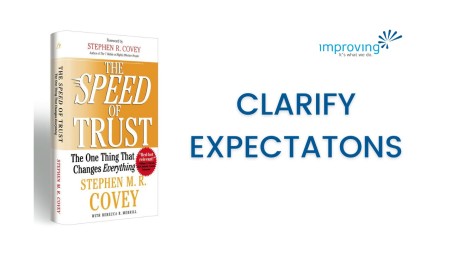If you do not know what a trust behavior is, it is a behavior/act that depends on another, if that behavior aligns with their expectations, it will strengthen and gain trust. You can use trust behaviors to communicate better. All trust behaviors are listed in the book titled “The Speed of Trust: The One Thing That Changes Everything” by Stephen M.R. Covey, which you can see copies of all over our offices.
Building and enabling these trust behaviors helps you understand where the other person is coming from, and vice versa. This is very helpful at work and can be applied to other parts of your life too.
How Does This Trust Behavior Make a Company Better?
In this business, making assumptions could be easy and harmful. If you are not really hearing what the client wants, it is going to be difficult to deliver what they are looking for. Here is a real-world example of this in action:
A client wants to build an amazing application and they are describing part of the design to you. They think they are describing a red square, but you are thinking of it as more rectangular. You hear a few of the client’s words and prematurely blurt out, “Oh I have got it! We can definitely do it!” without going back and clarifying.
Not only will you be unsuccessful with the project and the client will not be happy with the result, but it can also be a waste of time and resources. This could have been avoided during the initial meeting if you had instead said, “This is what I understood from our conversation. Is this correct?”
Recruiter Benefits for Using Clarify Expectations:
From a recruiter’s perspective, it is crucial to set expectations for candidates during the interview, hiring, and onboarding process. We need to communicate what Improving is looking for and the expectations for that specific role. This way there is no confusion when they start their position and they can prepare to do an awesome job as an Improver.
Also, if the candidate and I realized through clarifying expectations that they are not fit for the job, it does not mean that the relationship built through the interview process is broken. Now that the expectations are known, I could potentially come back to them if we have an opportunity that is better suited for them.
How Does Clarifying Expectations in the Onboarding Process Help Individual Employees?
If I effectively set expectations, new employees already have clear expectations of their roles and responsibilities when they begin working! They also know how to be successful from the start.
When a new Improver does not have a full understanding of their roles and responsibilities, we are failing to set them up for success. Even with the best intentions and work ethic, they could be going in the wrong direction and be blindsided when they're told it's not what we want.
How to Start Clarifying Expectations
To begin clarifying expectations in your own life and work, start asking questions. For me, it has been very helpful to step back, listen first, and understand the perspective of the other person. Then, I can ask questions to give me a better outlook on what needs to be done.
Trust behaviors are great because you have a language to communicate in and know the intentions on both sides of the equation. It helps people understand each other and ultimately that leads to trust.
If you want to learn more about our approach and experiences, we would love to talk with you. Contact us here!







